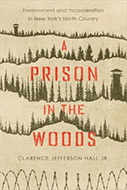A Prison in the Woods: Environment and Incarceration in New York’s North Country

Author: Clarence Jefferson Hall Jr.
Publisher: University of Massachusetts Press, 2020. 288 pages.
Reviewer: Angela S. Murolo | December 2022
Last summer, I went on a vacation to Plattsburgh, New York because of its proximity to Lake Champlain. Until I read A Prison in the Woods, I had no idea that there were multiple prisons in the Adirondack Park area. And that was the point. A Prison in the Woods outlines the rise in mass incarceration, New York state’s prison building boom, and the environmental impact on the state’s well-known recreation area – all while hiding in plain sight.
A Prison in the Woods delves into the Department of Correction’s mission to expand prison operations to accommodate New York state’s booming prison population, as well as the local politics and environmental activism that ensued. Included is a historical account of early efforts to punish criminal infractions in New York to the state’s increasing reliance on imprisonment.
With the rise of the Rockefeller Drug laws, long term imprisonment led to burgeoning prison populations, overcrowding, and a need to build, build, build. While “Downstaters” did not want prisons in their backyard, prisons were often seen as a panacea to Northern New York’s economy. Prisons were pitched as economic and job generators that would inject money and taxes into neighborhoods that were struggling from postindustrial decline. Blue collar neighborhoods, struggling with high unemployment rates, welcomed the opportunity to have prisons in their communities. Furthermore, A Prison in the Woods highlights the “benefits” that prison cities received from cheap prison labor, including industrial, social, and infrastructure projects that would otherwise be economic impossibilities. But this prospect came with an environmental cost, which concerned wealthy vacationers and property owners were not willing to pay.
The rise of incarceration in America, and in New York in particular, paralleled the rise of environmental laws; however, the powerful DOC was able to circumvent laws in countless communities based on the “emergency” building of more prisons to address continuous overcrowding. A Prison in the Woods also addresses the social harms of shipping people from New York City to Northern prisons, and the negative impacts it has on families and communities of color. Visitation is not cheap, nor easy, and can damage family bonds. Furthermore, Northerners were less than excited about the prospect of economically disadvantaged and minority families settling in their disproportionately middle class, White towns.
People concerned about environmental harms also developed various groups with some success, including abandoning plans for a sewage treatment plant, clean ups of prison-created water pollution, and abandoning the construction of some prisons or building smaller prisons. Public advocacy by various agencies included protest marches, letter writing campaigns, petition drives, and other forms of grass roots organizing.
Overall, the author does an effective job communicating the challenges that each Northern town encountered when prisons were built. Accounts of the historical significance, key players in support and protest of correctional building projects, and other details are included in a town-by-town, chapter-by-chapter format, which reads as repetitive at times. However, it is relevant to understand community-based dynamics and its impact on prison building and the environmental consequences.
This book is suitable for historians, criminologists, and students alike who are interested in the impacts of mass incarceration beyond the human costs. In fact, the author’s strength is showing that many towns, while desiring the economic benefits of a prison, were ill-prepared to accept the environmental costs that were associated with its presence.
Angela S. Murolo, PhD is an Assistant Professor at St. Francis College in Brooklyn.


